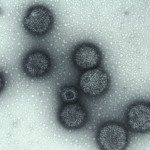Link to Pubmed [PMID] – 23785530
PLoS Negl Trop Dis 2013;7(6):e2255
Leishmaniasis is a complex parasitic disease from a taxonomic, clinical and epidemiological point of view. The role of genetic exchanges has been questioned for over twenty years and their recent experimental demonstration along with the identification of interspecific hybrids in natura has revived this debate. After arguing that genetic exchanges were exceptional and did not contribute to Leishmania evolution, it is currently proposed that interspecific exchanges could be a major driving force for rapid adaptation to new reservoirs and vectors, expansion into new parasitic cycles and adaptation to new life conditions. To assess the existence of gene flows between species during evolution we used MLSA-based (MultiLocus Sequence Analysis) approach to analyze 222 Leishmania strains from Africa and Eurasia to accurately represent the genetic diversity of this genus. We observed a remarkable congruence of the phylogenetic signal and identified seven genetic clusters that include mainly independent lineages which are accumulating divergences without any sign of recent interspecific recombination. From a taxonomic point of view, the strong genetic structuration of the different species does not question the current classification, except for species that cause visceral forms of leishmaniasis (L. donovani, L. infantum and L. archibaldi). Although these taxa cause specific clinical forms of the disease and are maintained through different parasitic cycles, they are not clearly distinct and form a continuum, in line with the concept of species complex already suggested for this group thirty years ago. These results should have practical consequences concerning the molecular identification of parasites and the subsequent therapeutic management of the disease.

